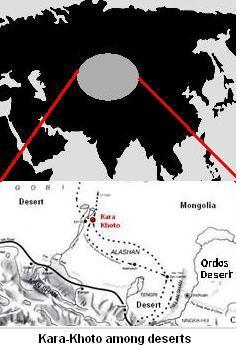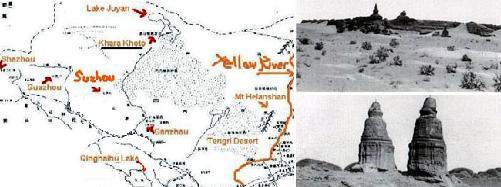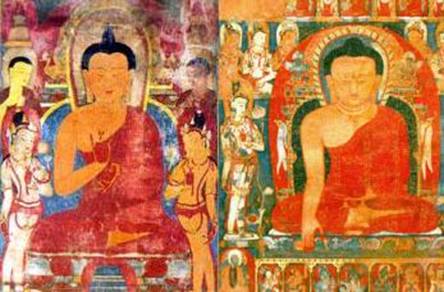|
The
western and northwestern regions of what is now China was
inhabited as early as the third millennium BC. These people
were known under the name of ‘Qiang’
(1),
a name clearly related to “Khang” meaning emperor or ruler
(see Chapter 5, Climatic
changes). The Central Asiatic region where the
ancient Qiang or equivalently the ancient Uighur empire once
resided became the source of several subsequent states, such
as the Tanguts, the Tartars, the Tibetans, the Tuguhuns, the
Xia, the Kushan, the Huns, the Gökturks and many other names
already mentioned in Chapter 1. These names are not listed
chronologically because our main interest is geared on
cultural relationships than on historical events based on
linear time. They all belonged to a common Uighur ancestry and
spoke different but connected Altaic languages.
Below
we see this vast region located in the center of Asia and
Kara-Khoto, the capital city of the Tangut empire, is
presently surrounded by deserts. The Tangut, before adopting
Buddhism were worshippers of the sky-god Tengri and shamanism
was the main spiritual belief system which served all ranks of
their society, from the court to the common people.

Tangut is a name formed out of two syllables which can be
split as either Tang-kut meaning “sacred sunrise”, which
became in time Tangut or Ot-tang-ut meaning “originating from
the fire”. Both forms have the same meaning and point to a
sun-worshipping culture. The Tangut capital Kara-Khoto is also
a meaningful Altaic name since
Kara means “land” but
is actually formed with Ok-Ara meaning “among the Ok”, while
Khoto or
Khutu means “the
sacred”, therefore Kara-Khoto becomes “the sacred Ok land”.
Even today we find cities called Kara Su, Kara-Vartak,
Kara-Teke, Kara-Þahr and Kara-Hoca. There is also a mountain
called Kara-Tagh in the region.
The region
where Kara-Khoto presently resides was once surrounded by
rivers and lakes. It was located at the mouth of the river
Heishui and the Lake Juyan (see map below). The ancient
neighboring towns were on the west Shazhou, Guazhou, Suzhou,
on the south Ganzhou and Gingha hui Lake, on the west the
yellow river. All these city names contain the phoneme “zhou”
or “su” which means “water” in Turkish. They are clear
indications of a fertile region with many waterways and lakes.
Furthermore, these dried-up lakes and rivers are vestiges of
an ancient inland see mentioned in Chapter 5,
Climatic changes.
Below we see
the dried-up lakes of the region surrounding Kara-Khoto
(underlined) on the left and the present situation of
Kara-Khoto on the right.

The Tangut
state occupied a vast region in Central Asia, from western
China up to and including Tibet. Scholars in general believe
that the culture of the Tangut was under the influence of the
Chinese and Tibetian Buddhism. But the Tangut, besides
believing in Buddhism did not forget their ancient sky and sun
shamanic religion. The Kara-Khoto collection of wall paintings
(tankas) contains no less than 26 images of the gods of
planets and constellations. If we consider that the Uighur
tribes due to climatic changes were forced to disperse in all
directions many thousand years ago, we can safely conclude
that the cultural influences originated from Central Asia and
affected neighboring nations.
In Chapter
17, The Indus Valley script, it has been shown that there is a
clear correlation in the dressing style of the ancient
Sumerian kings, the Indus Valley kings and the spiritual
leader of present Tibet, where the right arm is left
uncovered. The same dressing style is found among Buddhist
monks of Kara-Khoto as shown in the two examples below
(2).
 |
|
References
(1)
Lost Empire of the
Silk Road, Thyssen-Bornemisza Foundation publication, Edited
by M. Piotrovsky, page 49, 1993, Milano, Italy.
(2) Idem, pages 107 and
117.
|